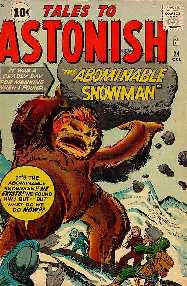|
YetiAbominable Snowman The legend of the abominable snowman is a curious one, primarily because it's so well known on the basis of so little legend.
The legend of the abominable snowman is a curious one, primarily because it's so well known on the basis of so little legend.With the Himalayas' rich panoply of religious influences and legends, nobody really thought a snowman running around the mountainside was especially noteworthy. Plenty of mythical beasties in the neighborhood match up with the general profile that we now lump together under "abominable snowman." The snowman's aliases include Migo, Mirka, Alma, Metohkangmi, Sogpa, Rashka and most famously Yeti. It wasn't until the British arrived in Tibet that anyone started to make a fuss about the so-called Yeti, which has been more or less uniformly described as an oversized ape-like creature not dissimilar to North America's Bigfoot. Yeti scholars, such as they are, place the first sighting of the snowman in 1832, when British explorer B.H. Hodson told tales of a "wild man ... covered in long, dark hair, and had no tail" who walked upright. What's inexplicable is why this and subsequent reports were interesting. There do exist apes that live in Asia, specifically orangutans. Although quite rare, they can grow to be extremely large. There are also bears, which are large and have no tails, and can stand on two feet. And monkeys. And nomadic humans who wander in the wilderness.
But this was the Victorian era, and the repressed British were suckers for anything that smacked of the unnatural, the lurid and the sensational. Brit adventurers were steadily flowing into the Himalayas for mountain-climbing and exploration, first driven by feeble-minded attempts to find the mythical Shangri-La, later by the desire to assert testicular fortitude by "conquering mountains."
Although the Yeti is considered a primarily Tibetan myth, sightings trickled in from as far north as China and as far south as India. Toward the end of the 19th century, however, the question of the Yeti took on a slightly more important dimension. In 1871, Charles Darwin published The Descent of Man, which proposed that humans were descended from primates. The resulting uproar is still going on today, but the debate at the time was far more heated. The intelligentsia of the day were particularly obsessed with the idea of the "missing link." In the early days of evolution, very little was clear, but horrified white Europeans were quite sure of one thing. There had to be some degrees of separation between them and the apes. A wild beast-man seemed like just the ticket. Since the British mountaineers swarming all over the Himalayas were almost universally drawn from the wealthy, educated noble class, they were keen to find an example of this proposed missing link. This fueled interest in a series of sightings and semi-sightings from around 1915 through 1925. Most of these reports included a description of oversized footprints. A well-publicized sighting by photographer N. A. Tombazi really got the ball rolling. Tombazi spotted the critter from a distance in 1925 as part of a British expedition. In a murky report, he related that it stood upright, appeared to be naked, and was strong enough to uproot bushes as it foraged (presumably for food). He found some large footprints in the snow, stubby but wide. Are you fascinated yet?? Bored Brits spent the next 40 years out searching for this thing, on the basis of these extraordinarily flimsy reports and with no particular incentive beyond the perennial "just for the hell of it." Once the frenzy began, the sightings came fast and furious, each more daffy than the next. Every scrap of animal remains discovered on a mountainside became a relic of the Yeti. Several opportunists produced "scalps" they said belonged to Snowmen, but these were all found to be fakes. One guy claimed a Snowman attacked him, another claimed one rescued him after a fall and nursed him back to health.
In the 40 years since, no one has come up with any proof of the Snowman's existence. While the world is full of strange and wonderful things, there comes a point where you have to cut your losses. At least with Bigfoot, there are a few blurry pictures of furry blobs with which to dress the myth (even if they were faked). Sure, there could be some kind of fancy ape wandering the mountains of Tibet. Hell, it's not even all that unlikely. But with such a dearth of evidence, it's hard to see how continuing The Search makes any sense at this late date. Especially when there's a Face on Mars to check out, and an Alien Autopsy to scrutinize, and I hear there are some little girls who keep fairies in their garden...
|
 While explorers kept their eyes peeled for the critter, there were few developments in the Yeti seach for the next 100 years or so. Even perennial crackpot
While explorers kept their eyes peeled for the critter, there were few developments in the Yeti seach for the next 100 years or so. Even perennial crackpot  The whole thing would have been long forgotten by now except that the eminently respectable Sir Edmund Hillary, the man who conquered Everest, decided to take a stab at it in 1960. But even Hillary dismissed the Yeti as a fiction after spending nearly a year on the hunt. One of his fellow expeditioneers, Desmond Doig, eventually decided there was a Yeti of yore, but that it was probably some kind of ape variant, which is what any sensible person would have decided in the first place.
The whole thing would have been long forgotten by now except that the eminently respectable Sir Edmund Hillary, the man who conquered Everest, decided to take a stab at it in 1960. But even Hillary dismissed the Yeti as a fiction after spending nearly a year on the hunt. One of his fellow expeditioneers, Desmond Doig, eventually decided there was a Yeti of yore, but that it was probably some kind of ape variant, which is what any sensible person would have decided in the first place.